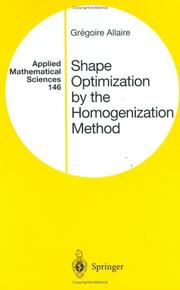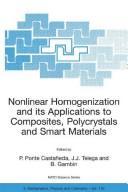| Listing 1 - 5 of 5 |
Sort by
|
Book
Abstract | Keywords | Export | Availability | Bookmark
 Loading...
Loading...Choose an application
- Reference Manager
- EndNote
- RefWorks (Direct export to RefWorks)
Book
ISBN: 3540548092 0387548092 3642846610 3642846599 9783540548096 Year: 1994 Publisher: Berlin : Springer-Verlag,
Abstract | Keywords | Export | Availability | Bookmark
 Loading...
Loading...Choose an application
- Reference Manager
- EndNote
- RefWorks (Direct export to RefWorks)
Partial differential equations --- Continuum mechanics --- Differential equations, Elliptic --- Homogenization (Differential equations) --- Milieux continus, Mécanique des --- Equations différentielles elliptiques --- Homogénéisation (Equations différentielles) --- Milieux continus, Mécanique des --- Equations différentielles elliptiques --- Homogénéisation (Equations différentielles)

ISBN: 9780198565543 0198565542 Year: 1999 Volume: 17 Publisher: Oxford ; New York : Oxford University Press,
Abstract | Keywords | Export | Availability | Bookmark
 Loading...
Loading...Choose an application
- Reference Manager
- EndNote
- RefWorks (Direct export to RefWorks)
Homogenization theory is a powerful method for modeling the microstructure of composite materials, including superconductors and optical fibers. This book is a complete introduction to the theory. It includes background material on partial differential equations and chapters devoted to the steady and non-steady heat equations, the wave equation, and the linearized system of elasticity.
Homogenization (Differential equations) --- Materials --- Homogénéisation (Equations différentielles) --- Matériaux --- Mathematical models. --- Modèles mathématiques --- 517.95 --- 519.63 --- 681.3*G18 --- Partial differential equations --- Numerical methods for solution of partial differential equations --- Partial differential equations: difference methods; elliptic equations; finite element methods; hyperbolic equations; method of lines; parabolic equations (Numerical analysis) --- Homogenization (Differential equations). --- 681.3 *G18 Partial differential equations: difference methods; elliptic equations; finite element methods; hyperbolic equations; method of lines; parabolic equations (Numerical analysis) --- 519.63 Numerical methods for solution of partial differential equations --- 517.95 Partial differential equations --- Homogénéisation (Equations différentielles) --- Matériaux --- Modèles mathématiques --- Engineering --- Engineering materials --- Industrial materials --- Engineering design --- Manufacturing processes --- Differential equations, Partial --- Mathematical models --- 681.3 *G18

ISBN: 9780387952987 0387952985 1441929428 1468492861 Year: 2002 Publisher: New York : Springer,
Abstract | Keywords | Export | Availability | Bookmark
 Loading...
Loading...Choose an application
- Reference Manager
- EndNote
- RefWorks (Direct export to RefWorks)
The topic of this book is homogenization theory and its applications to optimal design in the conductivity and elasticity settings. Its purpose is to give a self-contained account of homogenization theory and explain how it applies to solving optimal design problems, from both a theoretical and a numerical point of view. The application of greatest practical interest tar geted by this book is shape and topology optimization in structural design, where this approach is known as the homogenization method. Shape optimization amounts to finding the optimal shape of a domain that, for example, would be of maximal conductivity or rigidity under some specified loading conditions (possibly with a volume or weight constraint). Such a criterion is embodied by an objective function and is computed through the solution of astate equation that is a partial differential equa tion (modeling the conductivity or the elasticity of the structure). Apart from those areas where the loads are applied, the shape boundary is al ways assumed to support Neumann boundary conditions (i. e. , isolating or traction-free conditions). In such a setting, shape optimization has a long history and has been studied by many different methods. There is, therefore, a vast literat ure in this field, and we refer the reader to the following short list of books, and references therein [39], [42], [130], [135], [149], [203], [220], [225], [237], [245], [258].
Structural optimization. --- Homogenization (Differential equations) --- Optimisation des structures --- Homogénéisation (Equations différentielles) --- Homogenization (Differential equations). --- Homogénéisation (Equations différentielles) --- Buildings—Design and construction. --- Building. --- Construction. --- Engineering, Architectural. --- Applied mathematics. --- Engineering mathematics. --- Mathematical analysis. --- Analysis (Mathematics). --- Mechanics. --- Engineering design. --- Civil engineering. --- Building Construction and Design. --- Mathematical and Computational Engineering. --- Analysis. --- Classical Mechanics. --- Engineering Design. --- Civil Engineering. --- Engineering --- Public works --- Design, Engineering --- Industrial design --- Strains and stresses --- Classical mechanics --- Newtonian mechanics --- Physics --- Dynamics --- Quantum theory --- 517.1 Mathematical analysis --- Mathematical analysis --- Engineering analysis --- Architectural engineering --- Buildings --- Construction --- Construction science --- Engineering, Architectural --- Structural design --- Structural engineering --- Architecture --- Construction industry --- Design --- Mathematics --- Design and construction --- Composites --- Structural optimization --- Equations elliptiques/du deuxieme ordre --- Optimalisation morphologique --- Optimisation structurelle


ISBN: 1402026218 9786610190614 1280190612 1402026234 9400789246 1402026226 Year: 2004 Volume: 170 Publisher: Dordrecht ; London : Kluwer Academic Publishers,
Abstract | Keywords | Export | Availability | Bookmark
 Loading...
Loading...Choose an application
- Reference Manager
- EndNote
- RefWorks (Direct export to RefWorks)
Although several books and conference proceedings have already appeared dealing with either the mathematical aspects or applications of homogenization theory, there seems to be no comprehensive volume dealing with both aspects. The present volume is meant to fill this gap, at least partially, and deals with recent developments in nonlinear homogenization emphasizing applications of current interest. It contains thirteen key lectures presented at the NATO Advanced Workshop on Nonlinear Homogenization and Its Applications to Composites, Polycrystals and Smart Materials. The list of thirty one contributed papers is also appended. The key lectures cover both fundamental, mathematical aspects of homogenization, including nonconvex and stochastic problems, as well as several applications in micromechanics, thin films, smart materials, and structural and topology optimization. One lecture deals with a topic important for nanomaterials: the passage from discrete to continuum problems by using nonlinear homogenization methods. Some papers reveal the role of parameterized or Young measures in description of microstructures and in optimal design. Other papers deal with recently developed methods – both analytical and computational – for estimating the effective behavior and field fluctuations in composites and polycrystals with nonlinear constitutive behavior. All in all, the volume offers a cross-section of current activity in nonlinear homogenization including a broad range of physical and engineering applications. The careful reader will be able to identify challenging open problems in this still evolving field. For instance, there is the need to improve bounding techniques for nonconvex problems, as well as for solving geometrically nonlinear optimum shape-design problems, using relaxation and homogenization methods.
Homogenization (Differential equations) - Materials. --- Homogenization (Differential equations) --- Mathematics --- Engineering & Applied Sciences --- Physical Sciences & Mathematics --- Engineering - General --- Calculus --- Materials --- Polycrystals --- Composite materials --- Smart materials --- Polycrystalline solids --- Polycrystalline substances --- Homogénéisation (Equations différentielles) --- Polycristaux --- Matériaux intelligents --- Homogénéisation (Equations différentielles) --- Matériaux intelligents --- EPUB-LIV-FT LIVMATHE Nonlinear Polycrystals SPRINGER-B homogenization --- Crystals --- Differential equations, Partial --- Composites --- Congresses. --- Congrès --- Engineering. --- Engineering mathematics. --- Mechanics. --- Mechanics, Applied. --- Engineering, general. --- Mathematical and Computational Engineering. --- Solid Mechanics. --- Classical mechanics --- Newtonian mechanics --- Physics --- Dynamics --- Quantum theory --- Applied mechanics --- Engineering, Mechanical --- Engineering mathematics --- Engineering --- Engineering analysis --- Mathematical analysis --- Construction --- Industrial arts --- Technology --- Applied mathematics. --- Solids. --- Technology and Engineering. --- Mathematical and Computational Engineering Applications. --- Data processing. --- Solid state physics --- Transparent solids
| Listing 1 - 5 of 5 |
Sort by
|

 Search
Search Feedback
Feedback About UniCat
About UniCat  Help
Help News
News